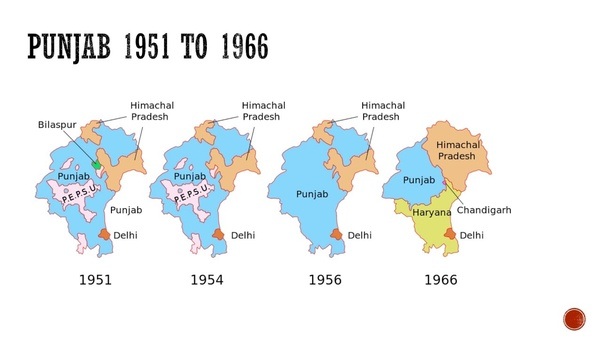 Punjab and Haryana (Punjab i Haryana)
Punjab and Haryana (Punjab i Haryana)
Hangman
the number of residents: 21,6 mln
Surface: 50,362 km*
Capital city: Chandigarh
Population na 1 km2:433
Official language: Punjabi
Illiteracy: 43%
Tourist season: X-III
damages
the number of residents: 21 mln
Surface: 44 212 km2
Capital city: Chandigarh
Population na 1 km2:407
Official language: hindi
Illiteracy: 55%
Tourist season: X-III
After the uprising preceding the division of India, the Punjab suffered enormous losses. Nevertheless, the efforts made by the inhabitants to rebuild their country have borne fruit and today it is the richest and most dynamically developing state of India.
In front of 1947 r., when did the state split, the area occupied by the Punjab included the areas currently located abroad with Pakistan. Former state capital as a result of a split, Lahore (Lahore), currently serves as the main city of Pakistani Punjab. During the uprising, as a result, the Punjab was split into two parts, there were often bloody clashes between the Sikhs and Hindus moving east and the Muslim population fleeing to the west.
W 1984 r. Punjab's so far stable policy has been shaken again. A group of Sikh extremists stormed the Golden Temple in Amritsar. It was only the military intervention of the Indian army that forced them to leave the building. Numerous terrorist actions, carried out in the early years 90. by five extremist groups, have made, that the Punjab is no longer visited by tourists. However, thanks to declining support for the radical actions of the Sikhs, a peaceful atmosphere reigned here again, which is eagerly used by foreign tourists.
The religious center of Sikhs living in Punjab is Amritsar. After the partition of India was planned, that the city would be the capital of the state. Due to its location close to the border with Pakistan, however, it was decided to move the capital deep into the country. Initially, this role was to be performed by Śimla, former summer seat of kings, but eventually Candigarh was chosen as the capital, new city built in the years 50.
Sikhs
The dynamic and successful development of the Punjab is due to the most interesting people of India, Sikhs. Detailed information on the Sikh religion and customs is provided in the Religions of India section.
Sikhs, in addition to religious beliefs, they are distinguished primarily by their appearance. It is unknown, What is the reason for this, but they are all well built. Obedient to the prohibition of cutting hair (you drink), they wear long beards, while the hair is hidden under the turban. The traditional clothing of Sikh women is salwar-kamiz: wide trousers and a long knee-length shirt. Both women, and men also call themselves sinhgami, that is, "Iwami”.
Despite the success of the Sikhs, these people are treated in India with irony and indulgence, like this, which he meets in the West, e.g.. Irish (obviously not in the West, but only in Great Britain, and not on the part of Europeans, but only the English; at the ed. Then. ed.). Although they are the subject of jokes and anecdotes, are famous for their amazing dexterity and exceptional manual skills. That's why Sikhs usually get jobs operating machinery, managing auto-rickshaws, cars, and even by airplanes.
W 1966 r. there was a second division of the Punjab. This time the state of Harjana was distinguished and the part inhabited predominantly by Sikhijksa who speak the Punjabi language. As a result of these changes, the northern regions of Punjab were incorporated into the state of Himaćal. Thus, the former capital of Chandigarh found itself on the border between Harjana and Punjab. W 1986 r., to mitigate conflicts caused by Sikhs, announced, that the city would become the capital of the Punjab. Unfortunately, Continued acts of violence delay the realization of this decision. Meanwhile, Candigarh is still the capital of both states, although the administrative center of the federal territory is Delhi.
The armed uprising and division caused enormous material losses. However, through judicious reconstruction, the Sikhs managed to make the Punjab the most thriving state. Income per capita is here twice as high as the national average (Harjana is second). Although the state's population is only 2,5% the entire population of India, the yields of wheat and rice obtained here are respectively 22% i 10% domestic production. A third of India's milk production also comes from the Punjab.
The main area of the economy in Punjab is agriculture. Factories were also built here, in.in. Hero Bicycle w Ludhianie – the largest bicycle factory in the world.
Punjabis do not shy away from alcohol. If you believe the statistics, they drink more of it than people in other states. It has become a tradition for Sikh men to wear a metal bracelet with an iron disc (karni), suitable for opening beer bottles.
Only, the real tourist attraction of the state is the magnificent Golden Temple in Amritsar. Only a few tourists choose a longer stay in Punjab and Hariana, the rest go to Himacal or Pakistan.